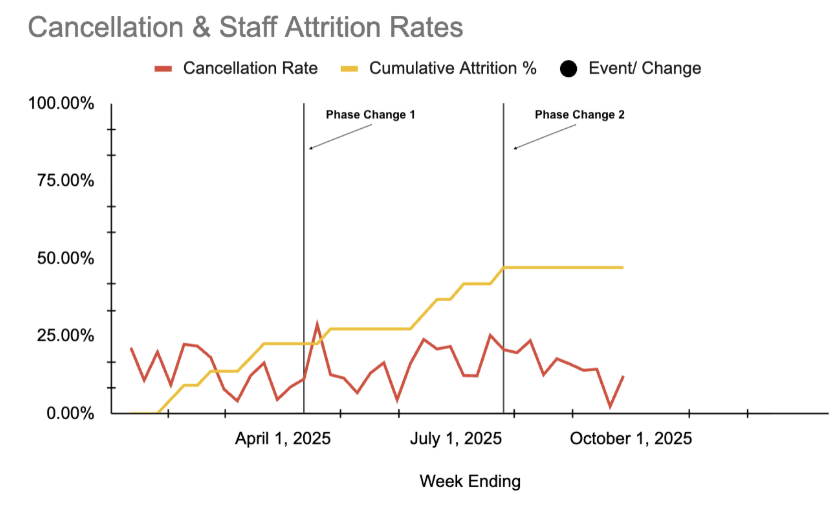We’re going to tell you a story about the roller coaster company culture of an Applied Behavior Analysis (ABA) clinic. What started as an amazing work environment with exceptionally high clinical quality and staff satisfaction quickly saw a rapid decline in morale. Acclaim Autism used Organizational Behavior Management (OBM) to turn the culture around into somewhere people want to work again, while maintaining high clinical quality throughout. We'll look at what they did, how they did it, and the valuable lessons that should be learned.

The Journey
The clinic was opened with a small but experienced team of dedicated staff. BCBA®s, and aspiring RBT®s who quickly became RBT® certified. Everyone shared the mission to provide high-quality individualized ABA in an area where it was hard to find, while becoming the best ABA service provider in the area.
With a high percentage of clients presenting with Medicaid insurance, funding was limited but workable. Caseloads were kept to a maximum in line with BACB standards, usually much less due to high hours cases. The team enjoyed learning from every client, regardless of complexity. Everyone got along well and was supportive of each other’s strengths and weaknesses. The clinic quickly grew, and the culture stayed positive.
One year in, everything was great. Staff turnover was 28.9%, which is low in the ABA field. People were happy.
Two years in, the team was feeling less supported due to the growth of the company and clinic. There were a lot of newer BCBAs that understandably needed more support. Staff turnover had increased to 67.1%.
An additional Director was hired. Staff felt supported again, and clinical quality improved even more. Families were incredibly engaged and grateful for such a dedicated, committed and talented team. Things started looking up again.
With a high percentage of clients presenting with Medicaid insurance, funding was limited but workable. Caseloads were kept to a maximum in line with BACB standards, usually much less due to high hours cases. The team enjoyed learning from every client, regardless of complexity. Everyone got along well and was supportive of each other’s strengths and weaknesses. The clinic quickly grew, and the culture stayed positive.
One year in, everything was great. Staff turnover was 28.9%, which is low in the ABA field. People were happy.
Two years in, the team was feeling less supported due to the growth of the company and clinic. There were a lot of newer BCBAs that understandably needed more support. Staff turnover had increased to 67.1%.
An additional Director was hired. Staff felt supported again, and clinical quality improved even more. Families were incredibly engaged and grateful for such a dedicated, committed and talented team. Things started looking up again.
Then, things got a little weird. BCBAs started reporting problems with the company. The good news was they were speaking up rather than staying quiet. The bad news was the complaints were numerous, and not easily ‘fixable’:
The list went on, and the word “Ethics” was weaponized against the company in almost every complaint. Then problems started compounding. One staff member would tell another about an ethical concern, the gossip mill would start, and the negativity compounded. Staff went from feeling positive about the company to overwhelmingly negative attitudes. In parallel with the cultural decline, the financial health of the clinic declined too.
Caseloads and major policies hadn’t changed, but the environment did.
Under the new Director, staff turnover declined but was still high:
Caseloads and major policies hadn’t changed, but the environment did.
Under the new Director, staff turnover declined but was still high:
The complaints were getting more and more numerous, and people were miserable. Human Resources (HR) and Leadership were receiving complaints about things from this clinic that didn’t seem to be an issue in other service areas.
OBM Assessment
The assessment revealed a lot:
The confusing misinformation being circulated was resulting in extreme dissatisfaction among staff when actual company policies were enforced by the organization. The actual policies were fair, transparent, and incredibly employee-friendly, but not communicated consistently to staff at this location. Inconsistent enforcement was also an issue.
Measurable Goals
The leadership team defined goals to help turn things around. The goals were essentially happier staff as measured by turnover, and consistent application of company policies. A goal was to decrease attrition to less than 50%, then less than 40%, and then 30% while monitoring caseloads and staff complaints. Another goal was to decrease cancellations from about 25% to 12%, and then further decrease from there. These are all quantifiable things that can be measured, that should be expected to move data towards a goal.
OBM Interventions & Data
The OBM interventions included:
As all these OBM interventions were implemented, the data were striking. Staff attrition and cancelled sessions are graphed below:

With the yellow line representing attrition, we were looking for the flat portions of the cumulative record to get longer and longer as these OBM interventions were implemented. The red line is the cancellation rate, with the percentage on the Y-axis, with the rate expected to go down. The first phase change was a resetting of expectations meeting with a BCBA. The second phase change was the resignation of someone who communicated a lot of incorrect policy data, as well as increased visits from company leadership. All other interventions were applied relatively consistently throughout, which essentially changed the environment in which people worked.
The data following these interventions includes:
The data following these interventions includes:
Lessons Learned
The cultural turnaround has been quite remarkable. Gina Barboni is the Director who oversaw this turnaround. The lessons learned are simple:
Simple practices using the science we love can help any ABA organization succeed and keep staff engaged and happy. That application ultimately results in lower turnover and better services for clients, which is why we all got into this field to start with.
ABA practice owners can reach out for support any time. We don’t do paid consulting, and are simply happy to have conversations with like-minded BCBAs trying to improve the field.
Gina Barboni
MA, BCBA
Jamie Turner
MBA, PMP, BCBA

